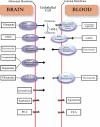Neurogenetics and Nutrigenomics of Neuro-Nutrient Therapy for Reward Deficiency Syndrome (RDS): Clinical Ramifications as a Function of Molecular Neurobiological Mechanisms
- PMID: 23926462
- PMCID: PMC3733258
- DOI: 10.4172/2155-6105.1000139
Neurogenetics and Nutrigenomics of Neuro-Nutrient Therapy for Reward Deficiency Syndrome (RDS): Clinical Ramifications as a Function of Molecular Neurobiological Mechanisms
Abstract
In accord with the new definition of addiction published by American Society of Addiction Medicine (ASAM) it is well-known that individuals who present to a treatment center involved in chemical dependency or other documented reward dependence behaviors have impaired brain reward circuitry. They have hypodopaminergic function due to genetic and/or environmental negative pressures upon the reward neuro-circuitry. This impairment leads to aberrant craving behavior and other behaviors such as Substance Use Disorder (SUD). Neurogenetic research in both animal and humans revealed that there is a well-defined cascade in the reward site of the brain that leads to normal dopamine release. This cascade has been termed the "Brain Reward Cascade" (BRC). Any impairment due to either genetics or environmental influences on this cascade will result in a reduced amount of dopamine release in the brain reward site. Manipulation of the BRC has been successfully achieved with neuro-nutrient therapy utilizing nutrigenomic principles. After over four decades of development, neuro-nutrient therapy has provided important clinical benefits when appropriately utilized. This is a review, with some illustrative case histories from a number of addiction professionals, of certain molecular neurobiological mechanisms which if ignored may lead to clinical complications.
Keywords: Brain reward circuitry; Dopamine; Neuro-nutrient therapy; Neuroadaptagen Amino-Acid Therapy™ (NAAT); Neurogenetics; Nutrigenomics; Reward Deficiency Syndrome(RDS); Reward Genes.
Figures














Similar articles
-
Coupling Neurogenetics (GARS™) and a Nutrigenomic Based Dopaminergic Agonist to Treat Reward Deficiency Syndrome (RDS): Targeting Polymorphic Reward Genes for Carbohydrate Addiction Algorithms.J Reward Defic Syndr. 2015;1(2):75-80. doi: 10.17756/jrds.2015-012. Epub 2015 Jun 24. J Reward Defic Syndr. 2015. PMID: 27617300 Free PMC article.
-
Neurogenetics and clinical evidence for the putative activation of the brain reward circuitry by a neuroadaptagen: proposing an addiction candidate gene panel map.J Psychoactive Drugs. 2011 Apr-Jun;43(2):108-27. doi: 10.1080/02791072.2011.587393. J Psychoactive Drugs. 2011. PMID: 21858957
-
Neurogenetic Impairments of Brain Reward Circuitry Links to Reward Deficiency Syndrome (RDS): Potential Nutrigenomic Induced Dopaminergic Activation.J Genet Syndr Gene Ther. 2012 Oct 17;3(4):1000e115. doi: 10.4172/2157-7412.1000e115. J Genet Syndr Gene Ther. 2012. PMID: 23264886 Free PMC article.
-
Molecular neurological correlates of endorphinergic/dopaminergic mechanisms in reward circuitry linked to endorphinergic deficiency syndrome (EDS).J Neurol Sci. 2020 Apr 15;411:116733. doi: 10.1016/j.jns.2020.116733. Epub 2020 Feb 14. J Neurol Sci. 2020. PMID: 32088516 Review.
-
Activation instead of blocking mesolimbic dopaminergic reward circuitry is a preferred modality in the long term treatment of reward deficiency syndrome (RDS): a commentary.Theor Biol Med Model. 2008 Nov 12;5:24. doi: 10.1186/1742-4682-5-24. Theor Biol Med Model. 2008. PMID: 19014506 Free PMC article. Review.
Cited by
-
Quantitative Electroencephalography Analysis (qEEG) of Neuro-Electro-Adaptive Therapy 12™ [NEAT12] Up-Regulates Cortical Potentials in an Alcoholic during Protracted Abstinence: Putative Anti-Craving Implications.J Addict Res Ther. 2014;5(1):1-7. doi: 10.4172/2155-6105.1000171. J Addict Res Ther. 2014. PMID: 25927012 Free PMC article.
-
Coupling Genetic Addiction Risk Score (GARS) and Pro Dopamine Regulation (KB220) to Combat Substance Use Disorder (SUD).Glob J Addict Rehabil Med. 2017 Feb;1(2):555556. doi: 10.19080/GJARM.2017.01.555556. Epub 2017 Feb 23. Glob J Addict Rehabil Med. 2017. PMID: 29399668 Free PMC article. No abstract available.
-
Genetic Addiction Risk Score (GARS): molecular neurogenetic evidence for predisposition to Reward Deficiency Syndrome (RDS).Mol Neurobiol. 2014 Dec;50(3):765-96. doi: 10.1007/s12035-014-8726-5. Epub 2014 May 31. Mol Neurobiol. 2014. PMID: 24878765 Free PMC article.
-
Enhancing Brain Pregnenolone May Protect Cannabis Intoxication but Should Not Be Considered as an Anti-addiction Therapeutic: Hypothesizing Dopaminergic Blockade and Promoting Anti-Reward.J Reward Defic Syndr. 2015;1(1):20-23. doi: 10.17756/jrds.2015-005. J Reward Defic Syndr. 2015. PMID: 26306328 Free PMC article.
-
KB220Z™ a Pro-Dopamine Regulator Associated with the Protracted, Alleviation of Terrifying Lucid Dreams. Can We Infer Neuroplasticity-induced Changes in the Reward Circuit?J Reward Defic Syndr Addict Sci. 2016;2(1):3-13. doi: 10.17756/jrdsas.2016-022. Epub 2016 May 19. J Reward Defic Syndr Addict Sci. 2016. PMID: 28210713 Free PMC article.
References
-
- Blum K, Kozlowski GP. Ethanol and neuromodulators interaction: a cascade model of reward. In: Ollat H, Parvez S, Parvez H, editors. Alcohol and Behavior. VSP Press Utrecht; The Netherlands: 1990.
-
- Bowirrat A, Oscar-Berman M. Relationship between dopaminergic neurotransmission, alcoholism, and Reward Deficiency syndrome. Am J Med Genet B Neuropsychiatr Genet. 2005;132B:29–37. - PubMed
-
- Moreira AB, Dias IL, Neto GO, Zagatto EA, Ferreira MM, et al. Solid-phase spectrofluorimetric determination of acetylsalicylic acid and caffeine in pharmaceutical preparations using partial least-squares multivariate calibration. Talanta. 2005;67:65–69. - PubMed
-
- Gross SB, Lepor NE. Anorexigen-related cardiopulmonary toxicity. Rev Cardiovasc Med. 2000;1:80–89. 102. - PubMed
Grants and funding
LinkOut - more resources
Full Text Sources
Other Literature Sources
